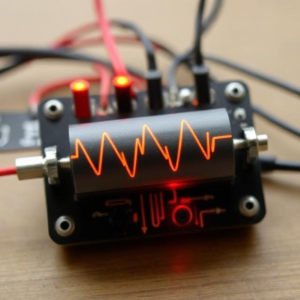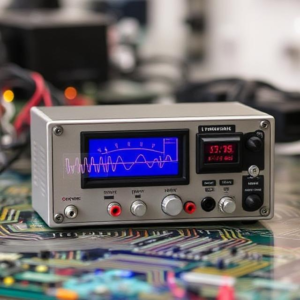An oscillator is a circuit that generates a repeating signal (usually in the form of a sine wave, square wave, or triangle wave) without needing an external signal to drive it. In simple terms, oscillators create their own rhythmic waves.

How Does It Work?
- An oscillator takes DC power (direct current) and converts it into an AC signal (alternating current) that continuously switches on and off.
- It typically involves components like resistors, capacitors, and sometimes transistors or operational amplifiers (Op-Amps).
- The key component is the feedback loop, where part of the output is fed back into the input to sustain the oscillation.
Examples of Oscillators:
- Clock Generators: Used in computers to keep time and synchronize processes.
- Radio Transmitters: Generate the carrier wave that is modulated with audio signals.
- Signal Generators: Create test signals for troubleshooting or testing other equipment.
- Types of Oscillators
There are several types of oscillators, but here are the most common ones:
- RC Oscillator
- RC Oscillators use resistors (R) and capacitors (C) to generate oscillations.
- The RC time constant determines the frequency of the oscillation.
How It Works:
- The capacitor charges and discharges through the resistor, creating a time delay that generates a repetitive waveform.
- Example: A simple Wien Bridge Oscillator is a type of RC oscillator that can produce a sine wave.
Uses:
- Low-frequency oscillators, such as in audio applications, tone generators, or simple radio circuits.
- LC Oscillator
- LC Oscillators use inductors (L) and capacitors (C) to generate oscillations.
- The inductor stores energy in a magnetic field, while the capacitor stores energy in an electric field, creating an alternating current that oscillates.
How It Works:
- The capacitor charges and discharges while the inductor releases energy, and together they create a constant oscillation.
Uses:
- Higher-frequency oscillators, such as in radio and TV transmitters, signal generators, or radio frequency (RF) circuits.
- Crystal Oscillator
- Crystal Oscillators use a quartz crystal (or similar material) to create highly stable and precise oscillations.
- When a voltage is applied to the crystal, it vibrates at a very specific frequency (due to the piezoelectric effect).
How It Works:
- The crystal’s mechanical vibrations generate an electrical signal at a fixed frequency.
Uses:
- Clock circuits in computers, mobile phones, and other devices where precise timing is important.
- Other Key Circuits in Electronics
In addition to oscillators, there are several other important circuits that control how signals behave in an electronic device. Let’s take a look at some of them:
- Amplifiers
An amplifier is a circuit that increases the strength of a signal. This is especially important in audio devices, where small sound signals need to be boosted to drive speakers.
- Types:
- Voltage Amplifiers: Increase the voltage of the input signal.
- Power Amplifiers: Increase both voltage and current, providing more power to drive loudspeakers or other components.
- Operational Amplifiers (Op-Amps): Versatile amplifiers used in many applications like filters, oscillators, and signal processing.











